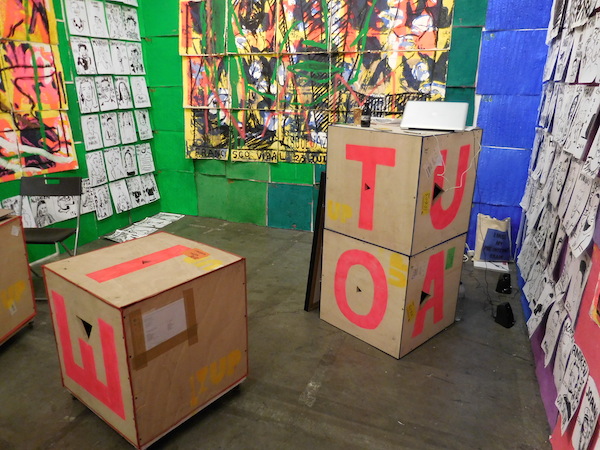
Image: Ben Davis
The Armory Show 2016 during the VIP preview.
Image: Ben Davis.
The Armory Show is upon us once again. The venerable New York fair has been battling the headwinds of global art fair competition for some time, fighting to retain its status as a must-see attraction. Earlier this year, it got a new director, the editor and writer (and my old boss) Benjamin Genocchio, following Noah Horowitz, who has decamped to work with the Art Basel franchise. Genocchio is tasked with injecting some kind of renewing vision to the whole thing.
What that might be, we can’t say yet. The wheels were already turning for this year’s edition. On first blush, the all-important Pier 94 “Contemporary” section feels pretty similar to other recent outings. It has about the same ratio of classiness and crassness, the same sense of a space at once airy and closely packed, part trade show and part circus. It feels business-as-usual-ish.
As always at an event of this size, there are little discoveries and moments to savor. Here are a few for which it is worth making the trip.
Barkley L. Hendricks, Photo Bloke (2016).
Image: Courtesy Jack Shainman.
At New York’s Jack Shainman, a full-length portrait by the great African American painter Barkley L. Hendricks (b. 1945), whose solo show at the Studio Museum in Harlem in 2009 was a real revelation. Its central figure, clad in a bubble-gum pink suit and suspended a bubble-gum pink background, shows an indelible portrait of stylish intelligence in form and content.
Untitled 2016 work by Njideka Akunyili Crosby at Victoria Miro.
Image: Ben Davis.
At London’s Victoria Miro, a large diptych by Nigerian-born, LA-based painter Njideka Akunyili Crosby (b. 1983) is so hot off the presses, the dealer told me, that the work was yet to be titled.
The left panel features a graceful self-portrait, the artist reclining in a crisply painted chair. The textures of the interior around her are rendered via a collage of textiles and photo-transfer images of Nigerian news items: the artist’s background rendered, literally, as background.
Ana Maria Tavares at Sicardi Gallery.
Image: Courtesy Sicardi Gallery.
At Houston’s Sicardi Gallery, the Brazilian artist Ana Maria Tavares (b. 1958) has a variety of hand-embroidered, lily pad-like soft sculptures suggesting the alluvial flora of the Amazon. Delicate but with accents of crafty psychedelia, the objects are installed in glass cases, deliberately courting a look somewhere between a science exhibit and a display of groovy jewelry.
Each year brings in a curated selection of galleries for the “Focus” section, which attempts to offer the hint of an edifying mission. This year the task fell to Yvette Mutumba and Julia Grosse, co-founders of Contemporary And, a magazine and online platform for “ideas, discourse and information on contemporary art practice from diverse African perspectives.” Their Armory mini-show, correspondingly, is simply called “African Perspectives.”
Yvette Mutumba and Julia Grosse.
Image: Rain Embuscado.
Pretending to represent a coherent perspective on an entire continent and its diaspora is folly, a fact of which these curators are certainly aware. “We always say that we are able to give a glimpse of the variety that is out there,” Grosse told me.
It’s nevertheless through this door that a few of the most interesting discoveries in the show enter.
Francisco Vidal at Tiwani Contemporary.
Image: Ben Davis.
London’s Tiwani Contemporary offers Portugal-born artist Francisco Vidal (b. 1978), who was one of last year’s representatives for Angola at the Venice Biennale. His full-booth display lines the space with messy, energetic color abstractions as well as grids of deft black-and-white drawings of friends, colleagues, and heroes; scrappy plywood boxes are scattered about the space, serving both as furniture and sculpture. The whole thing, as I understand it, is a demonstration of what Vidal calls the U.topia Machine, a scheme to pack the capacity of a pop-up art studio into the portable crates. The installation represents an overall proposal for making on-the-go art as much as it is a bunch of discrete works.
Cyrus Kabiru, Njia Ya Maisha, Macho Nne Trump (2016).
Image: Courtesy SMAC Gallery.
Cape Town’s SMAC Gallery presents Nairobi-born Cyrus Kabiru (b. 1984), who has forged a totally charming Afro-Futurist practice. Kabiru creates inventive sunglass/face mask hybrids from scrounged materials, then captures himself wearing them in photographic self-portraits.
Ibrahim al-Salahi, Calligraphic Forms III (1989).
Image: Courtesy Vigo Gallery.
The towering presence in “African Perspectives,” though, is Sudanese artist Ibrahim al-Salahi (b. 1930), at London’s Vigo gallery. The artist’s dreamy-but-lucid pen on canvas works have an otherworldly suggestiveness, sometimes hinting at personal stories, sometimes evoking mystic symbols, primeval artifacts, or alien machines.
Al-Salahi is a major figure in his home country, and one who has recently gathered greater and greater recognition for his unique synthesis of calligraphy, automatic drawing, and more. Recently, a show at the Tate Modern used him to inaugurate a series on “African Modernisms.” The work here is more than worth seeing; it the kind of work—rooted in a deep history but offering a fresh way of looking—that makes this whole circus feel worth something.